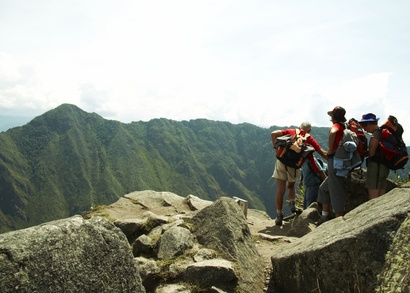Tourist information: Inca Trail
 The Citadel of Machu Picchu, due to its unique location in one of the most beautiful natural reserve in the world, has been offering one of the best venues in the world for the practice of an infinite number of adventure sports as well as the practice of other many forms of outdoor sports, which has been making in recent decades in one of the main attractions of this area of the Andes, whereas the hiking trail to the most important of America where you can reach many other activities such as camping, mountaineering, climbing, caving, mountain biking, descent of ravines and canyons, hiking, decline of rivers in canoes and kayaks, diving or fall free from bridges. Located to the East of the depression formed by Machu Picchu and Huayna Picchu mountain systems of the Central Andes in the South of the country, this geographical location on the eastern slope of the cordillera de Vilcanota at only 88 kilometers from the city of Cusco has many of the remains and ruins of stone built by all the slopes of these mountain systems representing the different historical periods of the Inca civilization who left their traces and history at the Citadel of Machu Picchu.
The Citadel of Machu Picchu, due to its unique location in one of the most beautiful natural reserve in the world, has been offering one of the best venues in the world for the practice of an infinite number of adventure sports as well as the practice of other many forms of outdoor sports, which has been making in recent decades in one of the main attractions of this area of the Andes, whereas the hiking trail to the most important of America where you can reach many other activities such as camping, mountaineering, climbing, caving, mountain biking, descent of ravines and canyons, hiking, decline of rivers in canoes and kayaks, diving or fall free from bridges. Located to the East of the depression formed by Machu Picchu and Huayna Picchu mountain systems of the Central Andes in the South of the country, this geographical location on the eastern slope of the cordillera de Vilcanota at only 88 kilometers from the city of Cusco has many of the remains and ruins of stone built by all the slopes of these mountain systems representing the different historical periods of the Inca civilization who left their traces and history at the Citadel of Machu Picchu.
The Inca Trail is the main path that used to communicate the Citadel of Machu Picchu with the different settlements in the surrounding areas of this zone of the Andes. Some of these routes or paths only had a symbolic, spiritual and religious value for the Inca civilization; However, other bands of the cordillera de Machu Picchu developed a series of settlements and populations along the Inca Trail, places that offered the traveler to rest and even stay overnight during their long journey to reach the Citadel of Machu Picchu.
The reason of such settlements is due to its length since the Inca Trail boasts approximately 88 kilometers from journey, starting from the official starting point in the train station that links Cuzco to Quillabamba, to pass through thick forests, ravines with narrow access steps, valleys completely covered by lush forests and countless wonders of this part of the Andes. Height, starting at 8,000 and reaching as far as 12,000 feet above sea level, is also something that determines the difficulty of the route, so are advised to the traveler, before carrying out any of the routes of the Inca Trail, make a stay in the area for at least one couple of days so that his body can become accustomed to the decreased levels of oxygen produced both altitude and environmental conditions.
Along the journey of about 4 days, the traveler will find a large number of ruins of great archaeological value, part of the historical heritage of the UNESCO. Some of them are Patallacta, Wiñay Huayna, Runkuraqay, Sayaqmarca, Killapata, Phuyupatamarca, Intipata and Chaskapata, ruins slowly introduce the traveler in the history of the Inca civilization and prepare you to watch the spectacular and amazing of them all, the Citadel of Machu Picchu.